The Guide describes the basic steps of installing and configuring a dedicated PC router running MikroTik RouterOS�. The following sections are included in this Guide:
- Setting up MikroTik RouterOS�
- Downloading and Installing the MikroTik RouterOS�
- 1. Download the basic installation archive file.
- 2. Create the installation media
- 3. Install the MikroTik RouterOS� software.
- Obtaining the Software License
- Logging into the MikroTik Router
- Adding Software Packages
- Software Licensing Issues
- Navigating the Terminal Console
- Accessing the Router Remotely Using Web Browser and WinBox Console
- Overview
- Starting the Winbox Console
- Overview of Common Functions
- Troubleshooting for Winbox Console
- Configuring Basic Functions
- Working with Interfaces
- Adding Addresses
- Configuring the Default Route
- Testing the Network Connectivity
- Application Examples
Setting up MikroTik RouterOS�
Downloading and Installing the MikroTik RouterOS�
The download and installation process of the MikroTik RouterOS� is described in the following diagram:
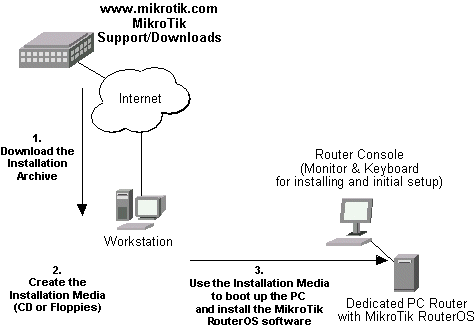
1. Download the basic installation archive file.
Depending on the desired media to be used for installing the MikroTik RouterOS� please chose one of the following archive types for downloading:- ISO image of the installation CD, if you have a CD writer for creating CDs. The ISO image is in the MTcdimage_v2-6-x_dd-mmm-yyyy.zip archive file containing a bootable CD image. The CD will be used for booting up the dedicated PC and installing the MikroTik RouterOS� on its hard-drive or flash-drive.
- MikroTik Disk Maker, if you want to create 3.5" installation floppies. The Disk Maker is a self-extracting archive DiskMaker_v2-6-x_dd-mmm-yyyy.exe file, which should be run on your Win95/98/NT4/2K/XP workstation to create the installation floppies. The installation floppies will be used for booting up the dedicated PC and installing the MikroTik RouterOS� on its hard-drive or flash-drive.
- MikroTik Disk Maker in a set of smaller files, if you have problems downloading one large file.
- Netinstall, if you want to install RouterOS� over a LAN with one floppy boot disk
Note! The installation from CD or network requires Full (paid) License. If you intend to obtain the Free Demo License, you should use the floppy installation media.
2. Create the installation media
Use the appropriate installation archive to create the Installation CD or floppies.- For the CD, write the ISO image onto a blank CD.
- For the floppies, run the Disk Maker on your Windows workstation to create the installation floppies. Follow the instructions and insert the floppies in your FDD as requested, label them as Disk 1,2,3, etc.
3. Install the MikroTik RouterOS� software.
Your dedicated PC router hardware should have:- An advanced 4th generation (core frequency 100MHz or more), 5th generation (Intel Pentium, Cyrix 6X86, AMD K5 or comparable) or newer Intel IA-32 (i386) compatible motherboard and processor (dual processors are not supported);
- from 32MB to 1GB RAM (from 48MB suggested);
- 30MB or more PRIMARY MASTER IDE HDD or IDE flashdrive. Note: The hard disk will be entirely reformatted during the installation and all data on it will be lost!
- A network adapter (NE2000 compatible PCI or ISA Ethernet card, or any other supported NIC, see specifications of supported interfaces on our web page);
For installation purposes (and only for that time) you should also have:
- A SECONDARY MASTER CD drive set as primary boot device, if you want to use the created CD for installing the MikroTik RouterOS� onto the primary master HDD;
- A 3.5" FDD set as primary boot device, if you want to use the created set of floppies for installing the MikroTik RouterOS�;
- A monitor and keyboard for installation and initial setup of the MikroTik Router. The monitor and keyboard do not need to be connected to the router after it is set up for connecting to it over the network.
After successful installation please remove the installation media from your CD or floppy disk drive and hit 'Enter' to reboot the router. While the router will be starting up for the first time you will be given a Software ID for your installation and asked to supply a valid software license key (Software Key) for it. Write down the Software ID. You will need it to obtain the Software License through the MikroTik Account Server.
If you need extra time to obtain the Software License Key, you may want to power off the router. Type shutdown in the Software key prompt and power the router off when the router is halted.
Obtaining the Software License
The MikroTik RouterOS™ Software licensing process is described in the following diagram:

After installing the router and starting it up for the first time you will be given a Software ID.
- Write down the Software ID reported by the RouterOS™.
- If you have an account with MikroTik, follow to the next step.
If you do not have an account at www.mikrotik.com, just press the 'New' button on the upper right-hand corner of the MikroTik's web page to create your account.
You will be presented with the Account Sign-Up Form where you chose your account name and fill in the required information.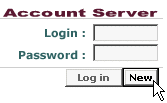
- To obtain the Software License Key,
log on to your account at www.mikrotik.com entering your account name and password
(upper right-hand corner on this webpage), for example:

- After logging on to the Account Server select "Free Demo License" or
"Order Software License" in the Account Menu.
Note! The CD or Netinstall installation cannot be 'unlocked' with the Free Demo Key. Use the Floppy installation, or, purchase the License Key.
- The Software Key will be sent to the email address, which has been specified in your account setup.
- Read your email and enter the Software Key at the router's console, for example:
Software ID: 5T4V-IUT Software key: 4N7X-UZ8-6SP
After entering the correct Software License Key you will be presented with the MikroTik Router's login prompt.
Logging into the MikroTik Router
When logging into the router via terminal console, you will be presented with the MikroTik RouterOS� login prompt. Use 'admin' and no password (hit 'Enter') for logging on to the router for the first time, for example:
MikroTik v2.6 Login: admin Password:
The password can be changed with the /password command.
Adding Software Packages
The basic installation comes with only the "system" package and few other packages. This includes basic IP routing and router administration. To have additional features such as IP Telephony, OSPF, wireless, and so on, you will need to download additional software packages.The additional software packages should have the same version as the system package. If not, the package wont be installed. Please consult the MikroTik RouterOS� Software Package Installation and Upgrading Manual for more detailed information about installing additional software packages.
Software Licensing Issues
If you want to upgrade to a 'paid' version of your MikroTik RouterOS� installation, please purchase the new Software License KEY for the Software ID you used when getting the 'free' demo license. Similarly, if additional license is required to enable the functionality of a software package, the license should be obtained for the Software ID of your system. The new key should be entered using the /system license set key command, and the router should be rebooted afterwards:
[admin@MikroTik] ip firewall src-nat> /system license print
software-id: "SB5T-R8T"
key: "3YIY-ZV8-DH2"
upgradable-unitl: may/01/2003
[admin@MikroTik] system license> feature print
Flags: X - disabled
# FEATURE
0 X AP
1 X synchronous
2 X radiolan
3 X wireless-2.4gHz
4 licensed
[admin@MikroTik] system license> set key=D45G-IJ6-QM3
[admin@MikroTik] system license> /system reboot
Reboot, yes? [y/N]: y
system will reboot shortly
If there is no appropriate license, the appropriate interfaces wont show up under the interface list, even though the packages can be installed on the MikroTik RouterOS� and corresponding drivers loaded.
Navigating the Terminal Console
After logging into the router you will be presented with the MikroTik RouterOS� Welcome Screen and command prompt, for example:
MMM MMM KKK TTTTTTTTTTT KKK MMMM MMMM KKK TTTTTTTTTTT KKK MMM MMMM MMM III KKK KKK RRRRRR OOOOOO TTT III KKK KKK MMM MM MMM III KKKKK RRR RRR OOO OOO TTT III KKKKK MMM MMM III KKK KKK RRRRRR OOO OOO TTT III KKK KKK MMM MMM III KKK KKK RRR RRR OOOOOO TTT III KKK KKK MikroTik RouterOS v2.6 (c) 1999-2002 http://www.mikrotik.com/ Terminal xterm detected, using multiline mode [admin@MikroTik] >
The command prompt shows the identity name of the router and the current menu level, for example:
[MikroTik] > Base level menu [MikroTik] interface> Interface configuration [MikroTik] ip address> IP Address management
The list of available commands at any menu level can be obtained by entering the question mark '?', for example:
[admin@MikroTik] > ?
driver Driver management
file Local router file storage.
import Run exported configuration script
interface Interface configuration
log System logs
password Change password
ping Send ICMP Echo packets
port Serial ports
quit Quit console
redo Redo previosly undone action
setup Do basic setup of system
undo Undo previous action
user User management
ppp
snmp snmp settings
isdn-channels ISDN channel status info
ip
queue Bandwidth management
system System information and utilities
tool
routing
export
[admin@MikroTik] > ip ?
accounting Traffic accounting
address Address management
arp ARP entries management
dns DNS settings
firewall Firewall management
neighbour neighbours
packing Packet packing settings
pool IP address pools
route Route management
service
policy-routing
dhcp-client DHCP client settings
dhcp-server DHCP server settings
dns-cache
ipsec
web-proxy HTTP proxy
telephony IP Telephony interface
export
[admin@MikroTik] > ip
The list of available commands and menus has short descriptions next to the items. You can move to the desired menu level by typing its name and hitting the [Enter] key, for example:
[admin@MikroTik]> Base level menu
[admin@MikroTik]> driver Enter 'driver' to move to the driver level
menu
[admin@MikroTik] driver> / Enter '/' to move to the base level menu
from any level
[admin@MikroTik]> interface Enter 'interface' to move to the interface
level menu
[admin@MikroTik] interface> /ip Enter '/ip' to move to the IP level menu
from any level
[admin@MikroTik] ip>
A command or an argument does not need to be completed, if it is not ambiguous. For example, instead of typing 'interface' you can type just 'in' or 'int'. To complete a command use the [Tab] key.
The commands may be invoked from the menu level, where they are located, by typing its name. If the command is in a different menu level than the current one, then the command should be invoked using its full or relative path, for example:
[admin@MikroTik] ip route> print Prints the routing table [admin@MikroTik] ip route> .. address print Prints the IP address table [admin@MikroTik] ip route> /ip address print Prints the IP address table
The commands may have arguments. The arguments have their names and values. Some arguments, that are required, may have no name. Below is a summary on executing the commands and moving between the menu levels:
Command Action
command [Enter] Execute the command
[?] Show the list of all available commands
command [?] Display help on the command and the list of arguments
command argument [?] Display help on the command's argument
[Tab] Complete the command/word. If the input is ambiguous, a
second [Tab] gives possible options
/ Move up to the base level
/command Execute the base level command
.. Move up one level
"" Enter an empty string
"word1 word2" Enter 2 words that contain a space
You can abbreviate names of levels, commands and arguments.
For the IP address configuration, instead of using the 'address' and 'netmask' arguments, in most cases you can specify the address together with the number of bits in the network mask, i.e., there is no need to specify the 'netmask' separately. Thus, the following two entries would be equivalent:
/ip address add address 10.0.0.1/24 interface ether1 /ip address add address 10.0.0.1 netmask 255.255.255.0 interface ether1
However, if the netmask argument is not specified, you must specify the size of the network mask in the address argument, even if it is the 32-bit subnet, i.e., use 10.0.0.1/32 for address 10.0.0.1 and netmask 255.255.255.255
Accessing the Router Remotely Using Web Browser and WinBox Console
The MikroTik router can be accessed remotely using- the telnet protocol, for example, using the telnet client of your Windows or Unix workstation. Working with the telnet console is the same as working with the monitor and keyboard attached to the router locally.
- the ftp for uploading the software upgrade packages or retrieving the exported configuration files.
- the http and WinBox Console, for example, using the web browser of your workstation.
Overview
The Winbox Console is used for accessing the MikroTik Router configuration and management features using graphical user interface.All Winbox interface functions are as close as possible to Console functions: all Winbox functions are exactly in the same place in Terminal Console and vice versa (except functions that are not implemented in Winbox). That is why there are no Winbox sections in the manual.
The Winbox Console plugin loader, the winbox.exe program, can be retrieved from the MikroTik router, the URL is http://router_address/winbox/winbox.exe Use any web browser on Windows 95/98/ME/NT4.0/2000/XP to retrieve the router's web page with the mentioned link.
The winbox plugins are cached on the local disk for each MikroTik RouterOS� version. The plugins are not downloaded, if they are in the cache, and the router has not been upgraded since the last time it has been accessed.
Starting the Winbox Console
When connecting to the MikroTik router via http (TCP port 80), the router's Welcome Page is displayed in the web browser, for example:

By clicking on the Winbox Console link you can start the winbox.exe download. Choose the option "Run this program from its current location" and click "OK":
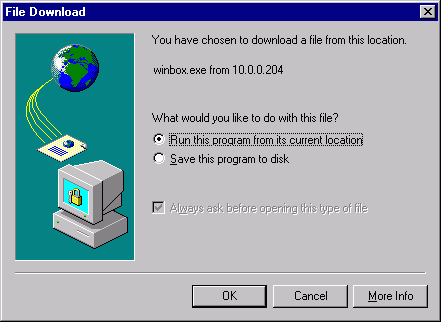
Accept the security warning, if any:
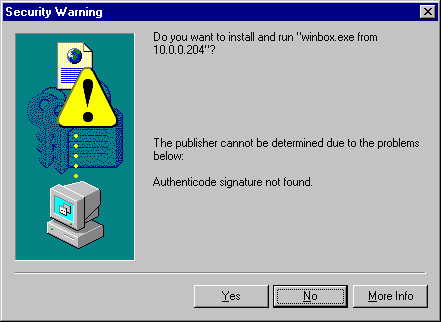
Alternatively, you can save the winbox.exe program to your disk and run it from there.
The winbox.exe program opens the Winbox login window. Login to the router by specifying the IP address, user name, and password, for example:
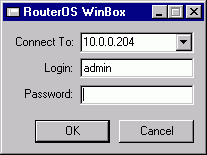
Watch the download process of Winbox plugins:
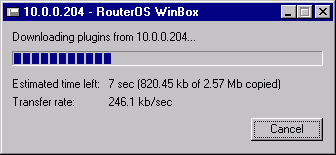
The Winbox console is opened after the plugins have been downloaded:

The Winbox Console uses TCP port 3987. After logging on to the router you can work with the MikroTik router's configuration through the Winbox console and perform the same tasks as using the regular console.
Overview of Common Functions
You can use the menu bar to navigate through the router's configuration menus, open configuration windows. By double clicking on some list items in the windows you can open configuration windows for the specific items, and so on.
There are some hints for using the Winbox Console:
- To open the required window, simply click on the corresponding menu item.
- To add a new entry you should click on the icon in the corresponding window.
- To remove an existing entry click on the icon.
- To enable an item, click on the icon.
- To disable an item, click on the icon.
- To make or edit a comment for a selected item, click on the icon.
- To refresh a window, click on the icon.
- To undo an action, click on the icon above the main menu.
- To redo an action, click on the icon above the main menu.
- To logout from the Winbox Console, click on the icon.
Troubleshooting for Winbox Console
- Cannot get the MikroTik RouterOS� Winbox to start.
The "Missing RouterOS Winbox plugins" message is displayed.
You can try to clear the winbox cache or wipe out the cache folder, and then reload the plugins:- To clear the winbox plugin cache on your computer,
choose the Clear Cache option in the Winbox system menu of the login window:

- To wipe out the winbox plugin cache on your computer,
find the cache file location using the registry
Key="HKEY_CURRENT_USER\Software\Microsoft\Windows\CurrentVersion\Explorer\
ShellFolders\AppData"
For example, for the user 'Administrator' on W2K, the Winbox folder is under
C:\Documents and Settings\Administrator\Application Data\Mikrotik
On W95/98 the Winbox folder is under C:\Windows\Application Data\Mikrotik
- To clear the winbox plugin cache on your computer,
choose the Clear Cache option in the Winbox system menu of the login window:
- I still cannot open the Winbox Console
The Winbox Console uses TCP port 3987. Make sure you have access to it through the firewall.
Configuring Basic Functions
Working with Interfaces
Before configuring the IP addresses and routes please check the /interface menu to see the list of available interfaces. If you have PCI Ethernet cards installed in the router, it is most likely that the device drivers have been loaded for them automatically, and the relevant interfaces appear on the /interface print list, for example:
[admin@MikroTik] interface> print Flags: X - disabled, D - dynamic, R - running # NAME TYPE MTU 0 R ether1 ether 1500 1 R ether2 ether 1500 2 R ether3 ether 1500 3 R ether4 ether 1500 4 R ether5 ether 1500 5 R sync1 sync 1500 6 R pc1 pc 1500 7 R ether6 ether 1500 8 R prism1 prism 1500 [admin@MikroTik] interface>
The device drivers for NE2000 compatible ISA cards need to be loaded using the add command under the /drivers menu. For example, to load the driver for a card with IO address 0x280 and IRQ 5, it is enough to issue the command:
[admin@MikroTik] driver> add name=ne2k-isa io=0x280 [admin@MikroTik] driver> print Flags: I - invalid, D - dynamic # DRIVER IRQ IO MEMORY ISDN-PROTOCOL 0 D RealTek 8139 1 D Intel EtherExpressPro 2 D PCI NE2000 3 ISA NE2000 280 4 Moxa C101 Synchronous C8000 [admin@MikroTik] driver>
The interfaces need to be enabled, if you want to use them for communications. Use the /interface enable name command to enable the interface with a given name, for example:
[admin@MikroTik] interface> print Flags: X - disabled, D - dynamic, R - running # NAME TYPE MTU 0 X ether1 ether 1500 0 X ether2 ether 1500 [admin@MikroTik] interface> enable 0 [admin@MikroTik] interface> enable ether2 [admin@MikroTik] interface> print Flags: X - disabled, D - dynamic, R - running # NAME MTU TYPE 0 R ether1 ether 1500 0 R ether2 ether 1500 [admin@MikroTik] interface>
You can use the number or the name of the interface in the enable command.
The interface name can be changed to a more descriptive one by using the /interface set command:
[admin@MikroTik] interface> set 0 name=Public [admin@MikroTik] interface> set 1 name=Local [admin@MikroTik] interface> print Flags: X - disabled, D - dynamic, R - running # NAME MTU TYPE 0 R Public ether 1500 0 R Local ether 1500 [admin@MikroTik] interface>
Use of the 'setup' Command
The initial setup of the router can be done by using the /setup command which enables an interface, assigns an address/netmask to it, and configures the default route. If you do not use the setup command, or need to modify/add the settings for addresses and routes, please follow the steps described below.Adding Addresses
Assume you need to configure the MikroTik router for the following network setup:
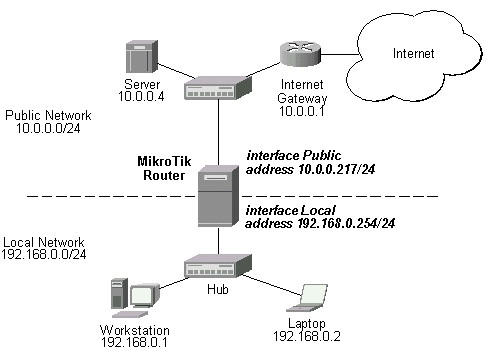
Please note that the addresses assigned to different interfaces of the router should belong to different networks. In the current example we use two networks:
- The local LAN with network address 192.168.0.0 and 24-bit netmask 255.255.255.0 The router's address is 192.168.0.254 in this network.
- The ISP's network with address 10.0.0.0 and 24-bit netmask 255.255.255.0 The router's address is 10.0.0.217 in this network.
[admin@MikroTik] ip address> add address 192.168.0.254/24 interface Local [admin@MikroTik] ip address> add address 10.0.0.217/24 interface Public [admin@MikroTik] ip address> print Flags: X - disabled, I - invalid, D - dynamic # ADDRESS NETWORK BROADCAST INTERFACE 0 10.0.0.217/24 10.0.0.217 10.0.0.255 Public 1 192.168.0.254/24 192.168.0.0 192.168.0.255 Local [admin@MikroTik] ip address>
Here, the network mask has been specified in the value of the address argument. Alternatively, the argument 'netmask' could have been used with the value '255.255.255.0'. The network and broadcast addresses were not specified in the input since they could be calculated automatically.
Configuring the Default Route
You can see two dynamic (D) and connected (C) routes, which have been added automatically when the addresses were added:
[admin@MikroTik] ip route> print
Flags: X - disabled, I - invalid, D - dynamic, J - rejected,
C - connect, S - static, R - rip, O - ospf, B - bgp
# DST-ADDRESS G GATEWAY DISTANCE INTERFACE
0 DC 192.168.0.0/24 r 0.0.0.0 0 Local
1 DC 10.0.0.0/24 r 0.0.0.0 0 Public
[admin@MikroTik] ip route> print detail
Flags: X - disabled, I - invalid, D - dynamic, J - rejected,
C - connect, S - static, R - rip, O - ospf, B - bgp
0 DC dst-address=192.168.0.0/24 preferred-source=192.168.0.254
gateway=0.0.0.0 gateway-state=reachable distance=0 interface=Local
1 DC dst-address=10.0.0.0/24 preferred-source=10.0.0.217 gateway=0.0.0.0
gateway-state=reachable distance=0 interface=Public
[admin@MikroTik] ip route>
These routes show, that IP packets with destination to 10.0.0.0/24 would be sent through the interface Public, whereas IP packets with destination to 192.168.0.0/24 would be sent through the interface Local. However, you need to specify where the router should forward packets, which have destination other than networks connected directly to the router. This is done by adding the default route (destination 0.0.0.0, netmask 0.0.0.0). In this case it is the ISP's gateway 10.0.0.1, which can be reached through the interface Public:
[admin@MikroTik] ip route> add gateway=10.0.0.1
[admin@MikroTik] ip route> print
Flags: X - disabled, I - invalid, D - dynamic, J - rejected,
C - connect, S - static, R - rip, O - ospf, B - bgp
# DST-ADDRESS G GATEWAY DISTANCE INTERFACE
0 S 0.0.0.0/0 r 10.0.0.1 1 Public
1 DC 192.168.0.0/24 r 0.0.0.0 0 Local
2 DC 10.0.0.0/24 r 0.0.0.0 0 Public
[admin@MikroTik] ip route>
Here, the default route is listed under #0. As we see, the gateway 10.0.0.1 can be reached through the interface 'Public'. If the gateway was specified incorrectly, the value for the argument 'interface' would be unknown. Note, that you cannot add two routes to the same destination, i.e., destination-address/netmask! It applies to the default routes as well. Instead, you can enter multiple gateways for one destination. For more information on IP routes, please read the relevant topic in the Manual.
If you have added an unwanted static route accidentally, use the remove command to delete the unneeded one. Do not remove the dynamic (D) routes! They are added automatically and should not be deleted 'by hand'. If you happen to, then reboot the router, the route will show up again.
Testing the Network Connectivity
From now on, the /ping command can be used to test the network connectivity on both interfaces. You can reach any host on both connected networks from the router:
[admin@MikroTik] ip route> /ping 10.0.0.4 10.0.0.4 64 byte pong: ttl=255 time=7 ms 10.0.0.4 64 byte pong: ttl=255 time=5 ms 10.0.0.4 64 byte pong: ttl=255 time=5 ms 3 packets transmitted, 3 packets received, 0% packet loss round-trip min/avg/max = 5/5.6/7 ms [admin@MikroTik] ip route> [admin@MikroTik] ip route> /ping 192.168.0.1 192.168.0.1 64 byte pong: ttl=255 time<1 ms 192.168.0.1 64 byte pong: ttl=255 time<1 ms 192.168.0.1 64 byte pong: ttl=255 time<1 ms 3 packets transmitted, 3 packets received, 0% packet loss round-trip min/avg/max = 0/0.0/0 ms [admin@MikroTik] ip route>
The workstation and the laptop can reach (ping) the router at its local address 192.168.0.254, If the router's address 192.168.0.254 is specified as the default gateway in the TCP/IP configuration of both the workstation and the laptop, then you should be able to ping the router:
C:\>ping 192.168.0.254 Reply from 192.168.0.254: bytes=32 time=10ms TTL=253 Reply from 192.168.0.254: bytes=32 time<10ms TTL=253 Reply from 192.168.0.254: bytes=32 time<10ms TTL=253 C:\>ping 10.0.0.217 Reply from 10.0.0.217: bytes=32 time=10ms TTL=253 Reply from 10.0.0.217: bytes=32 time<10ms TTL=253 Reply from 10.0.0.217: bytes=32 time<10ms TTL=253 C:\>ping 10.0.0.4 Request timed out. Request timed out. Request timed out. C:\>
You cannot access anything beyond the router (network 10.0.0.0/24 and the Internet), unless you do the following:
- Use source network address translation (masquerading) on the MikroTik router to 'hide' your private LAN 192.168.0.0/24 (see the information below), or
- Add a static route on the ISP's gateway 10.0.0.1, which specifies the host 10.0.0.217 as the gateway to network 192.168.0.0/24. Then all hosts on the ISP's network, including the server, will be able to communicate with the hosts on the LAN.
Next will be discussed situation with 'hiding' the private LAN 192.168.0.0/24 'behind' one address 10.0.0.217 given to you by the ISP.
Application Examples
Application Example with Masquerading
If you want to 'hide' the private LAN 192.168.0.0/24 'behind' one address 10.0.0.217 given to you by the ISP, you should use the source network address translation (masquerading) feature of the MikroTik router. Masquerading is useful, if you want to access the ISP's network and the Internet appearing as all requests coming from the host 10.0.0.217 of the ISP's network. The masquerading will change the source IP address and port of the packets originated from the network 192.168.0.0/24 to the address 10.0.0.217 of the router when the packet is routed through it.Masquerading conserves the number of global IP addresses required and it lets the whole network use a single IP address in its communication with the world.
To use masquerading, a source NAT rule with action 'masquerade' should be added to the firewall configuration:
[admin@MikroTik] ip firewall src-nat> add action=masquerade out-interface=Public
[admin@MikroTik] ip firewall src-nat> print
Flags: X - disabled, I - invalid
0 src-address=0.0.0.0/0:0-65535 dst-address=0.0.0.0/0:0-65535
out-interface=Public protocol=all icmp-options=any:any flow=""
limit-count=0 limit-burst=0 limit-time=0s action=masquerade
to-src-address=0.0.0.0 to-src-port=0-65535 bytes=0 packets=0
[admin@MikroTik] ip firewall src-nat>
Please consult the Firewall Manual for more information on masquerading.
Application Example with Bandwidth Management
Mikrotik RouterOS� V2.6 offers extensive queue management. For information on queue management, please refer to the relevant manual.Assume you want to limit the bandwidth to 128kbps on downloads and 64kbps on uploads for all hosts on the LAN. Bandwidth limitation is done by applying queues for outgoing interfaces regarding the traffic flow. It is enough to add two queues at the MikroTik router:
[admin@MikroTik] queue simple> add interface Local limit-at 128000
[admin@MikroTik] queue simple> add interface Public limit-at 64000
[admin@MikroTik] queue simple> print
Flags: X - disabled, I - invalid
0 name="" src-address=0.0.0.0/0 dst-address=0.0.0.0/0 interface=Local
limit-at=128000 queue=default priority=8 bounded=yes
1 name="" src-address=0.0.0.0/0 dst-address=0.0.0.0/24 interface=Public
limit-at=64000 queue=default priority=8 bounded=yes
[admin@MikroTik] queue simple>
Leave all other parameters as set by default. The limit is approximately 128kbps going to the LAN and 64kbps leaving the client's LAN. Please note, that the queues have been added for the outgoing interfaces regarding the traffic flow.
Please consult the Queues Manual for more information on bandwidth management and queuing.
Application Example with NAT
Assume we have moved the server in our previous examples from the public network to our local one:
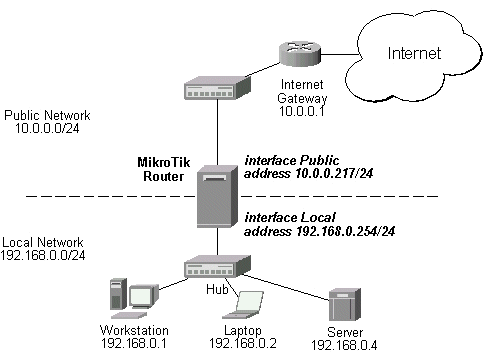
[admin@MikroTik] ip firewall dst-nat> add action=nat protocol=tcp \
dst-address=10.0.0.217/32:80 to-dst-address=192.168.0.4
[admin@MikroTik] ip firewall dst-nat> print
Flags: X - disabled, I - invalid
0 src-address=0.0.0.0/0:0-65535 in-interface=all
dst-address=10.0.0.217/32:80 protocol=tcp icmp-options=any:any flow=""
src-mac-address=00:00:00:00:00:00 limit-count=0 limit-burst=0
limit-time=0s action=nat to-dst-address=192.168.0.4 to-dst-port=0-65535
[admin@MikroTik] ip firewall dst-nat>
Please consult the Firewall Manual for more information on NAT.
� Copyright 1999-2002, MikroTik